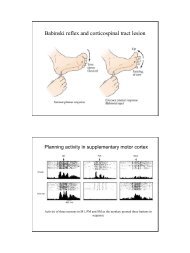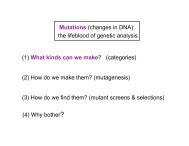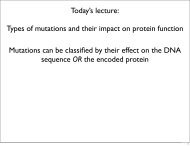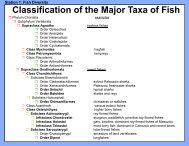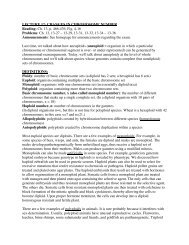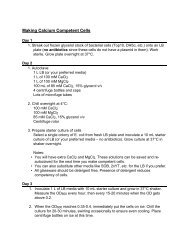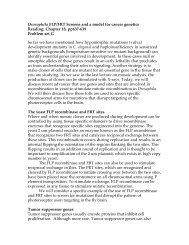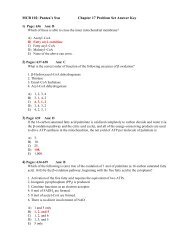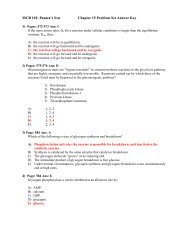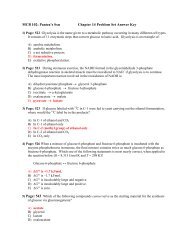Chapter 24 - Molecular and Cell Biology
Chapter 24 - Molecular and Cell Biology
Chapter 24 - Molecular and Cell Biology
You also want an ePaper? Increase the reach of your titles
YUMPU automatically turns print PDFs into web optimized ePapers that Google loves.
<strong>Chapter</strong> 9 Problem Set Answer Key MCB 102: Pantea’s Sxn<br />
1) Pages: 307-308 Ans: B<br />
The biological role of restriction enzymes is to:<br />
A) aid recombinant DNA research.<br />
B) degrade foreign DNA that enters a bacterium.<br />
C) make bacteria resistant to antibiotics.<br />
D) restrict the damage to DNA by ultraviolet light.<br />
E) restrict the size of DNA in certain bacteria.<br />
2) Page: 308 Ans: C<br />
Certain restriction enzymes produce cohesive (sticky) ends. This means that they:<br />
A) cut both DNA str<strong>and</strong>s at the same base pair.<br />
B) cut in regions of high GC content, leaving ends that can form more hydrogen bonds than ends of<br />
high AT content.<br />
C) make a staggered double-str<strong>and</strong> cut, leaving ends with a few nucleotides of single-str<strong>and</strong>ed<br />
DNA protruding.<br />
D) make ends that can anneal to cohesive ends generated by any other restriction enzyme.<br />
E) stick tightly to the ends of the DNA they have cut.<br />
3) Page: 311 Ans: E<br />
In the laboratory, recombinant plasmids are commonly introduced into bacterial cells by:<br />
A) electrophoresis – a gentle low-voltage gradient draws the DNA into the cell.<br />
B) infection with a bacteriophage that carries the plasmid.<br />
C) microinjection.<br />
D) mixing plasmids with an extract of broken cells.<br />
E) transformation – heat shock of the cells incubated with plasmid DNA in the presence of<br />
CaCl2.<br />
4) Page: 311 Ans: C<br />
A convenient cloning vector with which to introduce foreign DNA into E. coli is a(n):<br />
A) E. coli chromosome.<br />
B) messenger RNA.<br />
C) plasmid.<br />
D) yeast "ARS" sequence.<br />
E) yeast transposable element.
5) Pages: 319-321 Ans: B<br />
Which of the following statements about the polymerase chain reaction (PCR) is false?<br />
A) DNA amplified by PCR can be cloned.<br />
B) DNA is amplified at many points within a cellular genome.<br />
C) Newly synthesized DNA must be heat-denatured before the next round of DNA synthesis begins.<br />
D) The boundaries of the amplified DNA segment are determined by the synthetic oligonucleotides<br />
used to prime DNA synthesis.<br />
E) The technique is sufficiently sensitive that DNA sequences can be amplified from a single<br />
animal or human hair.<br />
6) Pages: 326-330 Ans: C<br />
Which one of the following analytical techniques does not help illuminate a gene’s cellular function?<br />
A) DNA microarray analysis<br />
B) Protein chip analysis<br />
C) Southern blotting<br />
D) Two-dimensional gel electrophoresis<br />
E) Two-hybrid analysis<br />
7) Pages: 310-312<br />
A plasmid that encodes resistance to ampicillin <strong>and</strong> tetracycline is digested with the restriction<br />
enzyme PstI, which cuts the plasmid at a single site in the ampicillin-resistance gene. The DNA is<br />
then annealed with a PstI digest of human DNA, ligated, <strong>and</strong> used to transform E. coli cells. (a) What<br />
antibiotic would you put in an agar plate to ensure that the cells of a bacterial colony contain the<br />
plasmid? (b) What antibiotic-resistance phenotypes will be found on the plate? (c) Which phenotype<br />
will indicate the presence of plasmids that contain human DNA fragments?<br />
Ans: (a) tetracycline; (b) tet R amp R <strong>and</strong> tet R amp S ; (c) The tet R amp S phenotype indicates that<br />
the gene for ampicillin resistance has been interrupted by the insertion of a human DNA<br />
fragment.<br />
8) Pages: 311-312<br />
Explain how each of the following is used in cloning in a plasmid: (a) antibiotic resistance genes; (b)<br />
origin of replication; (c) polylinker region.<br />
Ans: (a) Antibiotic resistance allows a researcher to select for a bacterial cell clone that carries<br />
the plasmid; loss of an antibiotic marker in a strain known to contain the plasmid can be used<br />
to infer the presence of a cloned DNA segment that interrupts the antibiotic resistance gene. (b)<br />
An origin of replication assures that the plasmid will replicate autonomously in the bacterium.<br />
(c) Polylinkers have cut sites for a variety of restriction enzymes, allowing insertion of DNA<br />
fragments produced with any of them.
9) Page: 320<br />
Why must the DNA polymerase used in the polymerase chain reaction (PCR) be heat stable?<br />
Ans: The PCR involves repeated heating of the reaction mixture (to denature the doublestr<strong>and</strong>ed<br />
DNA) <strong>and</strong> cooling (to allow hybridization of DNA with oligonucleotide primers). A<br />
heat-sensitive enzyme would be denatured by this procedure.<br />
10) Page: 322<br />
What are RFLPs <strong>and</strong> how are they used in forensic DNA fingerprinting technology?<br />
Ans: RFLPs (restriction fragment length polymorphisms) are minor variations among<br />
individuals in DNA base sequence that can be detected by variation in the patterns of fragments<br />
that are produced upon cleavage with restriction endonucleases. When several DNA regions<br />
are examined, these patterns are distinctive for an individual <strong>and</strong> can be used to determine the<br />
identity (or nonidentity) of two samples of DNA. One of these samples can be from a crime<br />
scene, the other from a known individual.<br />
11) Pages: 326-327<br />
What is a DNA microarray? How does it resemble <strong>and</strong> how does it differ from a DNA library?<br />
Ans: A DNA microarray is a solid surface upon which are placed DNA fragments from many<br />
thous<strong>and</strong>s of genes. It is in essence a form of DNA library that is arranged physically to allow<br />
rapid simultaneous screening of many thous<strong>and</strong>s of genes.



